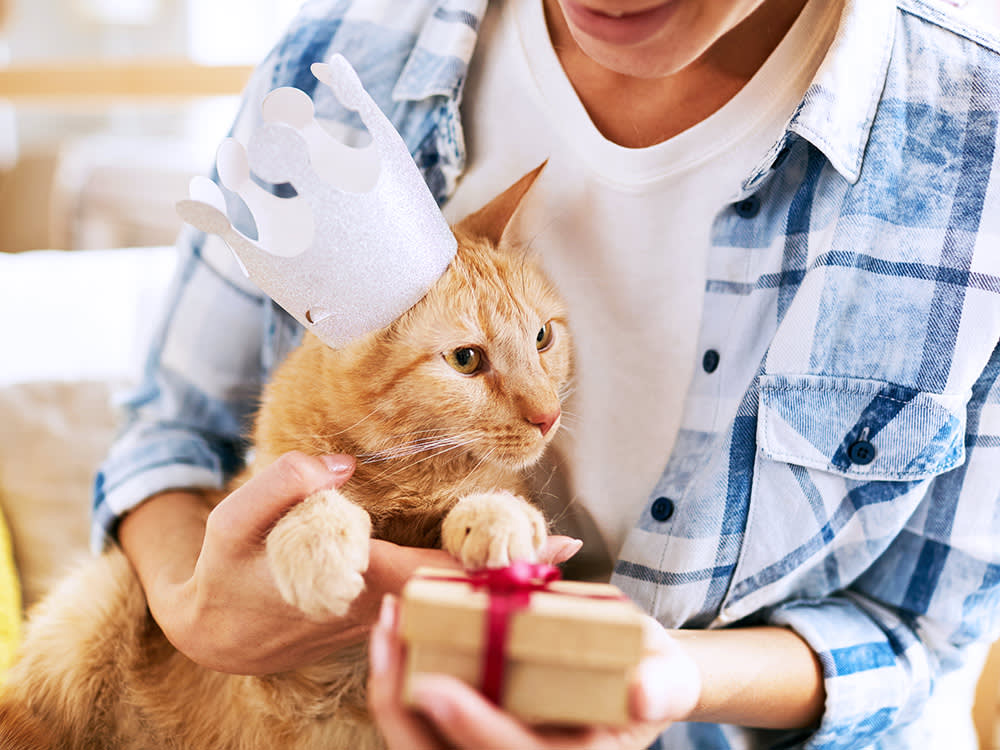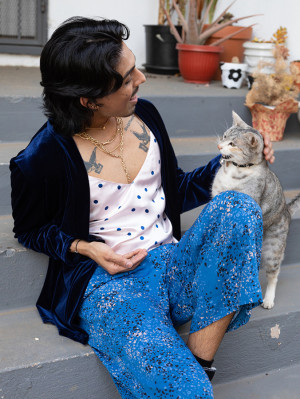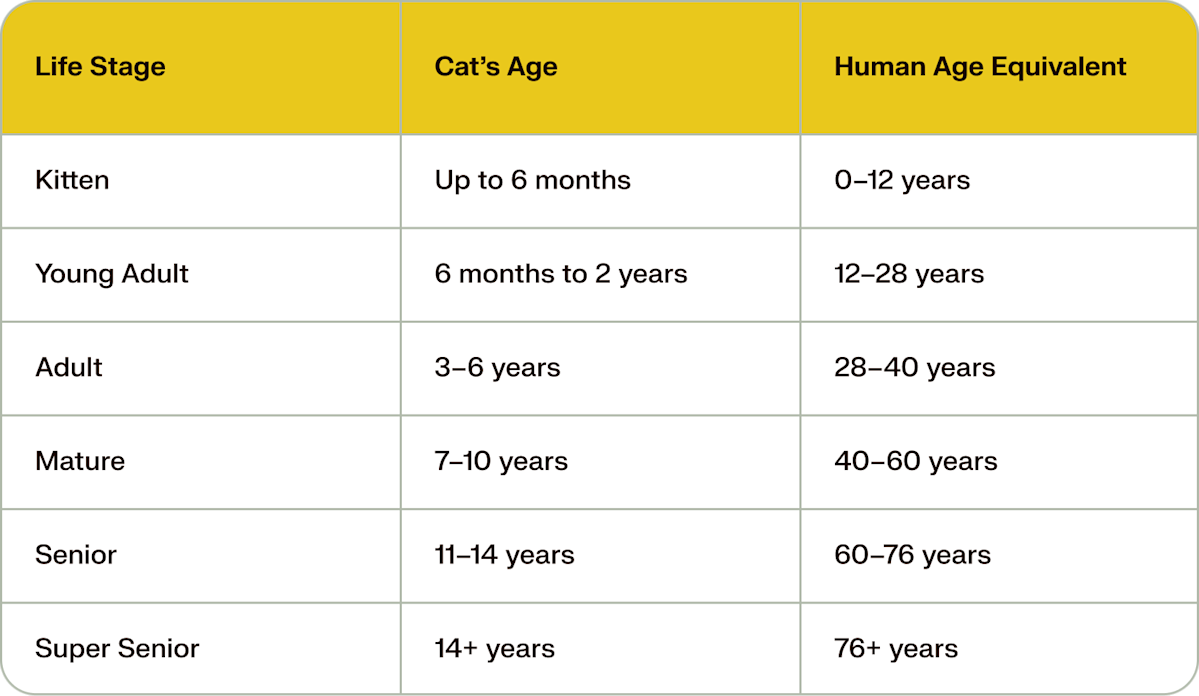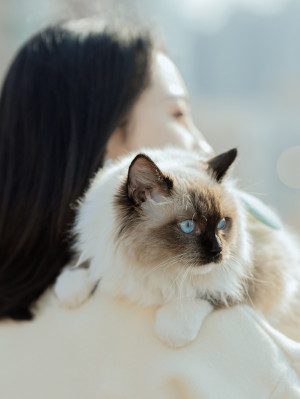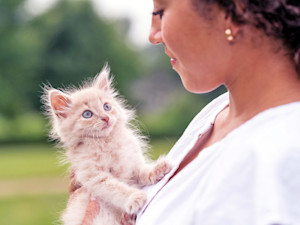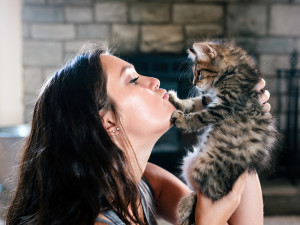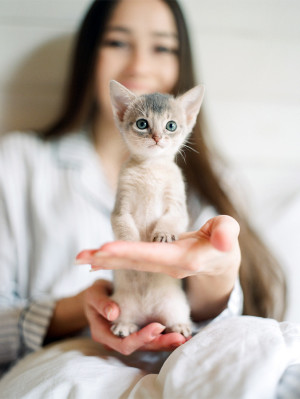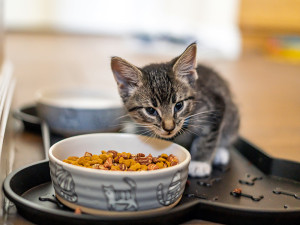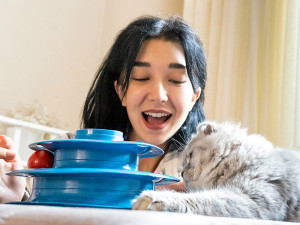Cat-Age Chart: Calculating Your Cat’s Age in Human Years
Know what to look for at every stage.
In This Article:
How to Tell a Cat’s Age How Many Cat Years Are in a Human Year? How Old Is My Cat in Human Years? Cat Milestones Comparison Maximizing Your Cat’s Lifespan Frequently Asked Questions
Unlike the myth that one human year always equals seven feline years, cats’ aging rate varies. They mature faster than humans do, reaching adulthood in their first two years. A kitten]s first year equals roughly 16 human years, slowing to a 4:1 yearly ratio once cats reach full adulthood.
How to tell a cat’s age
Some cat parents know exactly how old their cats are because they were there from the very beginning of their cat’s life. Others found their feline friends later in their life, making it harder to determine exactly how old their kitty is. Figuring out how to tell a cat’s age and what a cat’s age in human years is will help you know how to best care for your cat.
Cats mature at a different rate than humans do, so it’s good to know some important facts like at what age cats can get pregnant, at what age do cats go into heat, and at what age do cats stop growing. Some landmark ages in a cat’s development include:
How much do you spend on your pet per year?
Neonatal (birth to four weeks)
Kittens usually weigh between 90 and 110 grams at birth. They should gain 10-15 grams every day for the first three to four weeks of life. This means that they usually double their birth weight within just 10 days. By four weeks of age, kittens are able to eat a little bit of wet food, walk around (fairly steadily), and urinate and defecate on their own.
Pediatric (four weeks to six months)
Kittens mature rapidly between one and six months of age. They go from cute little fuzzballs to mischievous teenagersopens in new tab in the blink of an eye. They’ll get baby teeth, learn to chew their food, lose those teeth, and have a whole adult set show up in just a few months.
Juvenile (six months to one year)
Most cats are sexually mature by the time they’re six months old, though the possible range for sexual maturity is four to ten months of age. This means that your cat’s first heat cycle (and possible pregnancy) could happen a lot earlier than you’d expect.
Young adult (one to two years)
Most cats will have stopped growing by the time they’re a year old. This means that it’s time to switch to an adult diet because they no longer need all those extra nutrients and calories for growth. They may continue to fill out with muscle a little over the next year, but their frame should be set.
Adult (two to eight years)
Two-year-old cats are fully mature (though they may not act like it) and entering the prime years of their life. It’s important to continue to reinforce healthy behaviors and lifestyle choices through these years to make later life easier for your cat.
Senior (eight to 13 years)
Many senior cats are still spry and healthy, but you may notice some subtle signs of aging in these years. As your cat progresses through their senior years, your veterinarian may recommend additional check-ins to make sure no problems are developingopens in new tab.
Super senior (13+ years)
Geriatric cats can still lead happy lives, but they may need a little extra help to do it. Being on top of preventative care, weight management, and any medical issues will help your cat age gracefully.
How many human years are in a cat year?
Because kittens mature so quickly, the number of human years in a cat year varies early in their life. Cats speed through their growth phases, reaching their “teenage years” at around six months old. A one-year-old cat would just be settling into their sophomore year of high school, while a two-year-old cat would be graduating college.
Once a cat is older than two, they age more steadily. After two years old, a cat ages the equivalent of four human years for each year that passes. This means that your 18-year-old cat would be well into their 80s, if measured in human years.
How old is my cat in human years?
If you want to figure out your cat’s age in human years, a chart can be helpful. No chart is going to be perfect for any cat, but using a cat-human age chart can help to give you a general idea of how to think about your cat’s age relative to your own.
Cat milestones comparison
It’s important to know what to expect as your cat ages. Whether figuring out if your kitten is progressing normally or trying to plan for your senior cat’s health needs, knowing a few milestones can help give you some perspective.
Baby teeth: Kittens speed through tooth development, popping out a full set of baby teeth in just two months. Human babies take almost three years to get all their baby teeth in.
Adult teeth: Almost in the blink of an eye, kittens begin losing those baby teeth, and adult teeth start coming in. Kittens usually begin losing their baby teeth at about four months of age and most have a full set of adult teeth by the time they’re seven months old. Humans take much longer, with their second molars coming through when they’re 11 to 13 years old.
Puberty: Male kittens can start to be fertile when they’re about five or six months old. Similarly, female kittens can get pregnant very young, often as soon as six months of age. In humans, this happens at about 11 to 14 years of age, depending on the country. It’s not a good idea to let kittens this young get pregnant, though. They’re not fully grown yet, so pregnancy and birth can pose significant risks.
Loss of fertility: Cats don’t go through menopause like humans do, so it’s technically possible for them to get pregnant well into their senior years. Cats as old as 14 have had kittens, but a pregnancy at this age poses a significant risk to their health.
Mature size: Cats usually reach their full size by the time they’re a year old. In humans, this happens at about 16 years of age for women and 18 for men.
Maximizing your cat’s lifespan
When thinking about your cat’s age, it’s helpful to think about ways that you can make the most of your cat’s years with you. It’s important to consider both the amount of time you get to spend with your kitty and how you can make that time as enjoyable as possible for them. Some ways to maximize your cat’s lifespan in both years and quality include:
Feeding a high-quality diet
Visiting the vet for routine care
Maintaining a healthy body weight
Keeping your cat indoors
Being aware of your cat’s changing needs as they age will let you help them age gracefully. After all, every cat is convinced that they deserve the best from life, so it’s the least you can do to try to provide it for them.
FAQs (People also ask):
How do cats age?
Cats mature very rapidly through the first year of their life, but then their aging process steadiesopens in new tab after that. Once they’re mature, cats age about as much as a human would in four years each year.
How old is my senior cat?
Estimating an adult or senior cat’s true age can be difficult. There’s no definitive method, but your veterinarian may be able to give you a possible age range and some suggestions for senior cat care.
What is the average lifespan of an indoor cat?
The average cat lives about 14 or 15 years, but there is great variation by breed. The expected lifespan of cats has been increasing over time with improvements in at-home and veterinary care.
References:
Life Expectancy Tables for Dogs and Cats Derived From Clinical Dataopens in new tab
Estimation of Age by Examination of the Teeth in Animalsopens in new tab
Parametric Survival Analysis of Menarche Onset Timing Among Nigerian Girlsopens in new tab
